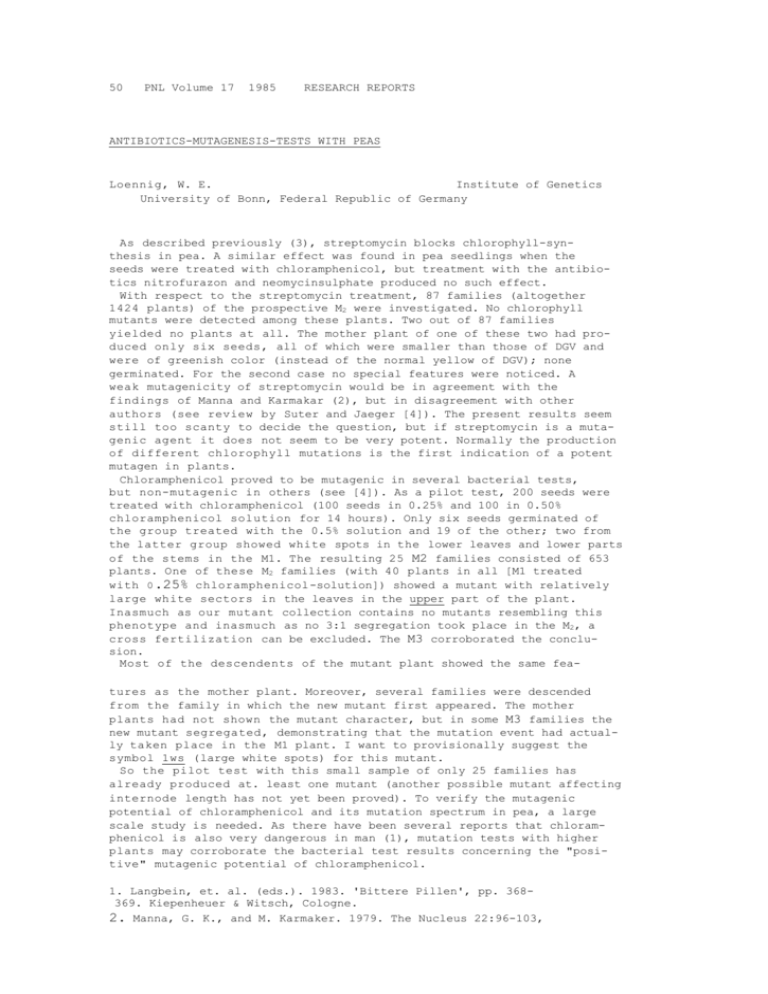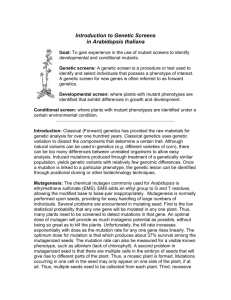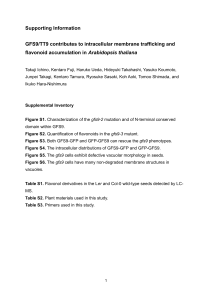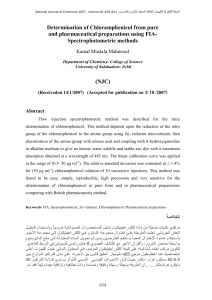plant moreover
advertisement

50 PNL Volume 17 1985 RESEARCH REPORTS ANTIBIOTICS-MUTAGENESIS-TESTS WITH PEAS Loennig, W. E. Institute of Genetics University of Bonn, Federal Republic of Germany As described previously (3), streptomycin blocks chlorophyll-synthesis in pea. A similar effect was found in pea seedlings when the seeds were treated with chloramphenicol, but treatment with the antibiotics nitrofurazon and neomycinsulphate produced no such effect. With respect to the streptomycin treatment, 87 families (altogether 1424 plants) of the prospective M2 were investigated. No chlorophyll mutants were detected among these plants. Two out of 87 families yielded no plants at all. The mother plant of one of these two had produced only six seeds, all of which were smaller than those of DGV and were of greenish color (instead of the normal yellow of DGV); none germinated. For the second case no special features were noticed. A weak mutagenicity of streptomycin would be in agreement with the findings of Manna and Karmakar (2), but in disagreement with other authors (see review by Suter and Jaeger [4]). The present results seem still too scanty to decide the question, but if streptomycin is a mutagenic agent it does not seem to be very potent. Normally the production of different chlorophyll mutations is the first indication of a potent mutagen in plants. Chloramphenicol proved to be mutagenic in several bacterial tests, but non-mutagenic in others (see [4]). As a pilot test, 200 seeds were treated with chloramphenicol (100 seeds in 0.25% and 100 in 0.50% chloramphenicol solution for 14 hours). Only six seeds germinated of the group treated with the 0.5% solution and 19 of the other; two from the latter group showed white spots in the lower leaves and lower parts of the stems in the M1. The resulting 25 M2 families consisted of 653 plants. One of these M2 families (with 40 plants in all [M1 treated with 0 .25% chloramphenicol-solution]) showed a mutant with relatively large white sectors in the leaves in the upper part of the plant. Inasmuch as our mutant collection contains no mutants resembling this phenotype and inasmuch as no 3:1 segregation took place in the M2, a cross fertilization can be excluded. The M3 corroborated the conclusion. Most of the descendents of the mutant plant showed the same features as the mother plant. Moreover, several families were descended from the family in which the new mutant first appeared. The mother plants had not shown the mutant character, but in some M3 families the new mutant segregated, demonstrating that the mutation event had actually taken place in the M1 plant. I want to provisionally suggest the symbol 1ws (large white spots) for this mutant. So the pilot test with this small sample of only 25 families has already produced at. least one mutant (another possible mutant affecting internode length has not yet been proved). To verify the mutagenic potential of chloramphenicol and its mutation spectrum in pea, a large scale study is needed. As there have been several reports that chloramphenicol is also very dangerous in man (1), mutation tests with higher plants may corroborate the bacterial test results concerning the "positive" mutagenic potential of chloramphenicol. 1. Langbein, et. al. (eds.). 1983. 'Bittere Pillen', pp. 368369. Kiepenheuer & Witsch, Cologne. 2. Manna, G. K., and M. Karmaker. 1979. The Nucleus 22:96-103, PNL Volume 17 1985 RESEARCH REPORTS 3. Loennig, W.-E. PNL 15:36-37. 4. Suter, W. and I. Jaeger. 1982. Mutation Res. 97:1-18. Fig. 1. M3: Descendants of chlorophyll mutant which appeared after treatment with chloramphenicol. CAROTENOID COMPOSITION AND PROVITAMIN A VALUES OF F2 SEEDS FROM THE CROSS OF WL 3527 (orc) x Wt 11145 (Orc) Ludwicki J., and W. K. Swiecicki . Agricultural University/SGGW, Warsaw, Poland Plant Experiment Station, Wiatrowo, Poland The composition and content of carotenoids was investigated in dry and fresh seeds of lines Wt 3527 (orc I- yellow cotyledons), Wt 11145 Orc 1 - orange cotyledons), and in dry F2 seeds of the hybrid Wt 3527 x Wt 11145. F2 seeds were divided into five groups: yellow, dark yellow, l i g h t o r a n g e , orange, brick (see [ 1 ] ) . The seeds were ground and hydrolyzed (KOH in alcohol) prior to extraction with hexane. Chromatographic separation of carotenoids was done on an MgO column using hexane as the mobile phase followed by 10 and 20% solutions of acetone in hexane. Moreover, the separation of pigments was investigated by TLC on s i l i c a gel using solvent mixture of hexane-ethylacetate-methanol (75:20:7) as the mobile phase. The content of a given carotenoid was estimated on the basis of a spectrophotometric assay using tabular values of E1%1cm, viz: beta-carotene 2 5 9 2 ; beta-cryptoxanthin 2386; lutein 2550. For the determination of the provitamin A value, the biological activity of beta-carotene was taken as 100% b e t a -cryptoxanthin as 57% , and lutein as 0%. 2










